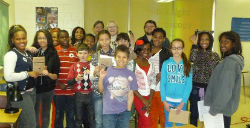2013 - 2014 IDEA Grants
“Fill the Gap,” Filling a Pipeline Gap to our Next Generation of Scientists
by Amy Wilkerson, Applied Research Center
The main objective of the “Fill the Gap” project is to introduce children, ranging from 6 to 18 years old (K-12), at the Boys & Girls Club of Suffolk (BGCS) after-school enrichment program to materials characterization. One of the objectives of the “Fill the Gap” project is to introduce the Suffolk BGCS kids to spectroscopy and to provide a hands-on experience with a mini-spectrometer. During the grant period I presented, along with two co-workers, an interactive, hands-on Build Your Own Mini-Spectrometer workshop for the BGCS children. Beginning with an introductory power point presentation to teach the students about visible light spectroscopy, the kids were then able to build their own mini-spectrometer that they were allowed to keep and take home. We provided a variety of new light sources which were displayed in custom built units that we constructed. The BGCS participants included middle school age children, a BGCS assistant, and the BGCS Director, Reggie Carter. The middle school children represented John F. Kennedy, Kings Fork, and Forest Glen Middle Schools, 6th through 8th grade. Newsletters about the events have been written for our Applied Research Center Newsletter and has been placed on our website.
“Transition and Transformation: Increasing Awareness & Appreciation of Diversity”
by Therese Lovegreen, Academic Advising
The Peer Advising program provides a network of support for new students, and contributes to the mission of the university with a focus on service to the institution students, and community. The grant supported a training workshop to provide students with an increased awareness and understanding of all aspects of diversity and inclusion. Approximately 90 students participated in the workshop. The facilitator was Mr. Raymond Plaza, Associate Director of Multicultural Affairs at Bowling Green State University. At the conclusion of the workshop, the students:
- identified campus tools available for support
- practiced listening and speaking skills
- listed ways to advise students or talk with new students they work with in their role as a peer advisors
- practiced how they would advise students without bias or stereotype
- Students identified special needs of their advisees and appropriate campus resources that can support students















